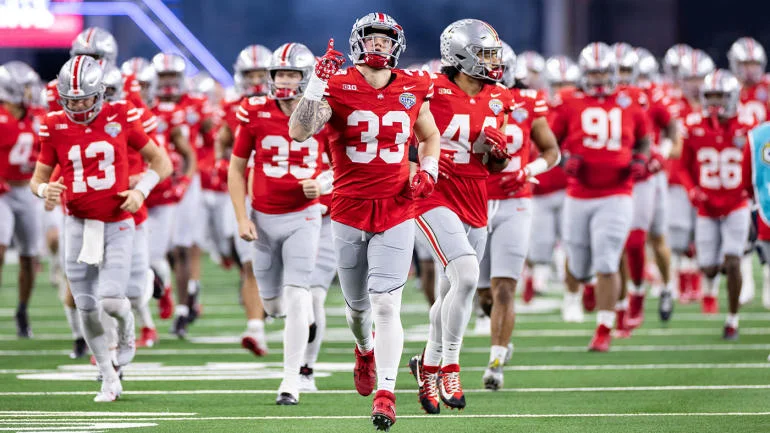The landscape of college football has undergone a seismic shift in recent years with the introduction of Name, Image, and Likeness (NIL) deals. What was once a strictly amateur sport, where players were expected to perform for little more than scholarships and the love of the game, has transformed into a high-stakes financial arena where top athletes can now earn substantial sums. Among the most talked-about developments in this new era is the staggering amount of money reportedly flowing into Ohio State’s football program through NIL agreements. While exact figures are often shrouded in secrecy, estimates suggest that Buckeyes players have collectively received “around $20 million” in NIL compensation—a number that, if accurate, would make Ohio State one of the most financially dominant programs in the country.
The rise of NIL money has fundamentally altered recruiting, player retention, and team dynamics. For decades, college football programs relied on tradition, coaching prestige, and facilities to attract top talent. Now, while those factors still matter, the ability to secure lucrative endorsement deals and sponsorship opportunities has become a critical selling point. Ohio State, with its massive fan base, strong alumni network, and high-profile brand, was always positioned to thrive in this new environment. The Buckeyes’ football program is a national powerhouse, consistently competing for championships and producing NFL talent. That kind of visibility makes its players incredibly marketable, and businesses—both local and national—have been eager to capitalize.
The $20 million figure, while unconfirmed by official sources, aligns with the broader trends in college football’s NIL economy. Top-tier programs like Alabama, Texas, and Georgia are also rumored to be funneling millions to their athletes through collectives—third-party organizations that pool funds from boosters and businesses to facilitate deals for players. At Ohio State, the collective known as “The Foundation” has been instrumental in securing NIL opportunities for Buckeyes athletes. Reports indicate that some of the team’s biggest stars, including quarterback Quinn Ewers (before his transfer) and wide receiver Marvin Harrison Jr., have landed deals worth six or even seven figures.
What makes Ohio State’s situation particularly noteworthy is the sheer breadth of its NIL operations. Unlike some schools where a handful of star players command the majority of the money, the Buckeyes appear to have a more distributed model, with numerous players benefiting from the program’s financial ecosystem. This approach not only helps in recruiting but also fosters team cohesion, as players up and down the roster can share in the rewards of their collective success. It’s a modern twist on the old adage that winning takes care of everything—except now, winning also means securing life-changing money for athletes who, until recently, were barred from profiting off their own fame.
Of course, the explosion of NIL money hasn’t been without controversy. Critics argue that what was supposed to be a system allowing players to earn modest compensation for endorsements has morphed into a thinly veiled pay-for-play structure, where the highest bidder often wins in recruiting battles. There’s also concern about transparency, as many NIL deals are private arrangements with undisclosed terms. The NCAA, which initially resisted any form of player compensation, has struggled to enforce meaningful regulations, leading to a Wild West environment where the richest programs can flex their financial muscle with few restrictions.
For Ohio State, the benefits of this new system are undeniable. The Buckeyes have always recruited at an elite level, but NIL has given them an additional edge. When a five-star prospect is deciding between multiple blue-blood programs, the promise of significant NIL earnings can be the deciding factor. And it’s not just about landing high school recruits—transfer portal players, who now have the freedom to switch schools without sitting out a year, are also drawn to programs that can offer immediate financial incentives. Ohio State’s ability to retain its own stars has also improved, as players who might have left early for the NFL now have the option to stay and capitalize on their college fame.
The impact of NIL money extends beyond the players themselves. Coaches and administrators must now navigate an entirely new dimension of roster management. Ohio State’s head coach, Ryan Day, has been vocal about the importance of NIL in maintaining the program’s competitiveness. In a now-famous statement, he suggested that it would take $13 million annually to keep the Buckeyes’ roster intact—a number that underscores just how high the financial stakes have become. While some traditionalists bristle at the idea of college football becoming a semi-professional enterprise, the reality is that the genie is out of the bottle. Programs that fail to adapt risk falling behind, and Ohio State has made it clear that it intends to be at the forefront of this revolution.
Looking ahead, the question isn’t whether NIL money will continue to shape college football, but rather how far it will go. The $20 million figure associated with Ohio State may soon be eclipsed as collectives become more sophisticated and corporate sponsors increasingly view college athletes as viable brand ambassadors. There’s also the looming possibility of revenue sharing between schools and players, which could further blur the line between collegiate and professional sports. For now, Ohio State’s reported windfall serves as a testament to the program’s marketability and the changing nature of amateur athletics.
In the end, the rise of NIL compensation is a double-edged sword. On one hand, it provides long-overdue financial opportunities for players who generate billions in revenue for their schools and the NCAA. On the other, it introduces complexities that could disrupt competitive balance and further separate the haves from the have-nots. For Ohio State, a program accustomed to operating at the sport’s highest level, the ability to leverage NIL money effectively ensures that the Buckeyes will remain a force to be reckoned with. Whether this new era is good for the sport as a whole remains to be seen, but one thing is certain: college football will never be the same.



